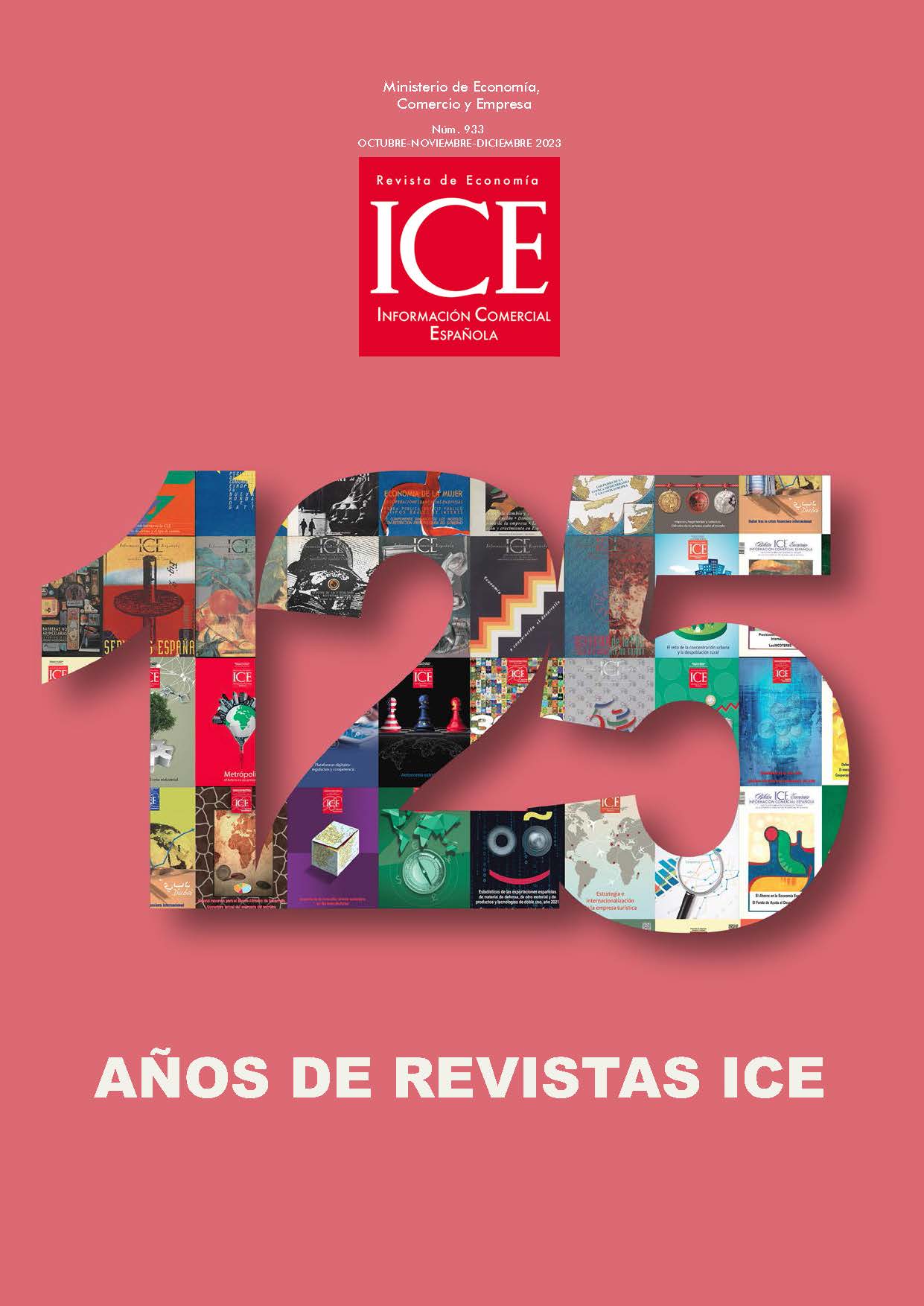Women in the Spanish economy: closing the gap in employment and digitisation
##plugins.themes.bootstrap3.article.sidebar##
Downloads
##plugins.themes.bootstrap3.article.main##
This article reviews some of the challenges to equality between women and men in the Spanish economy, considering the digitalization process and the pending tasks for closing the gender gap. Although there have been significant advances in Spain with respect to the European average in female empowerment, and the differences in the labor market that work against women have been gradually diminishing over time, we must not lose sight of the characteristics of access to the digital economy, fundamentally in terms of qualifications and training in technological matters, to not to lose pace on the road to full equality.
##plugins.themes.bootstrap3.article.details##
- Isabel Álvarez, Víctor Martín, Value chains in Europe and strategic autonomy , ICE, Revista de Economía: No. 916 (2020): La Unión Europea tras la pandemia
- Elena Cerdá-Mansilla, Isabel Álvarez, The internationalization of Spanish universities: collaboration patterns, results and challenges , ICE, Revista de Economía: No. 913 (2020): Internacionalización de las economías, nuevas formas, estrategias y actividades
- Juan José Durán, Isabel Álvarez, The International Expansion of Multinational Enterprises. Structure and Institutional Nature , ICE, Revista de Economía: No. 909 (2019): Multinacionales en un cambiante contexto internacional
- Isabel Álvarez, Antonio Biurrun, Digitalization as a post-pandemic recovery asset , ICE, Revista de Economía: No. 924 (2022): La crisis de la COVID-19: el camino de la recuperación
- Angie Mariana Aray, Isabel Álvarez, Gender diversity and collaboration for innovation in Spanish companies , ICE, Revista de Economía: No. 921 (2021): Mujer y economía: igualdad, oportunidades y retos
- Isabel Álvarez, Introducción , ICE, Revista de Economía: No. 921 (2021): Mujer y economía: igualdad, oportunidades y retos
- Isabel Álvarez, Juan José Durán, Presentación , ICE, Revista de Economía: No. 909 (2019): Multinacionales en un cambiante contexto internacional
Adams, R. B., & Ferreira, D. (2009). Women in the boardroom and their impact on governance and performance. Journal of Financial Economics, 94(2), 291-309.
Álvarez, I. (2021). Introducción. Información Comercial Española (ICE), Revista de Economía, 921, 5-10. https://revistasice.com/index.php/ICE/article/view/7278/7315
Álvarez, I. y Biurrun, A. (2022). La digitalización como baza de recuperación pospandemia. Información Comercial Española (ICE), Revista de Economía, 924, 197-213. https://doi.org/10.32796/ice.2022.924.7357
Baer, M., Vadera, A. K., Leenders, R. T. A. J., & Oldham, G. R. (2013). Intergroup competition as double-edged sword: How sex composition regulates the effects of competition on group creativity. Organization Science, 25(3), 892-908.
Casarico, A., & Lattanzio, S. (2023). Behind the child penalty: understanding what contributes to the labour market costs of motherhood. Journal of Population Economics, 36(3), 1489-1511. https://doi.org/10.1007/s00148-023-00937-1
Chen, S., Ni, X., & Tong, J. Y. (2016). Gender Diversity in the Boardroom and Risk Management: A Case of R&D Investment. Journal of Business Ethics, 136(3), 599-621. https://www.jstor.org/stable/i24735902
Christiansen, L. E., Lin, H., Pereira, J., Topalova, P., & Turk Ariss, R. (2016). Gender Diversity in Senior Positions and Firm Performance: Evidence from Europe (IMF Working Paper No. 50). International Monetary Fund.
Comisión Europea. (2022). Digital Economy and Society Index 2022: overall progress but digital skills, SMEs and 5G networks lag behind. European Commission, Brussels.
COTEC. (2021). La economía digital en España. Avances y retos por regiones y sectores. Fundación COTEC, Madrid.
De Quinto, A., Hospido, L., Sanz, C. (2021). The child penalty: evidence from Spain. SERIEs, 12, 585-606. https://doi.org/10.1007/s13209-021-00241-9
De Santis, R. A., Roos, M., Hettler, K., & Tamburrini, F. (2018). Purchases of green bonds under the Eurosystem’s asset purchase programme’. ECB Economic Bulletin, 7.
Degli-Esposti, S. (2021). El rol del análisis de género en la reducción de los sesgos algorítmicos. Información Comercial Española (ICE), Revista de Economía, 921, 127-143. https://doi.org/10.32796/ice.2021.921.7265
Goldin, C. (1990). Understanding the gender gap – An Economic History of American Women. Oxford University Press.
Goldin, C. (2006). The Quiet Revolution That Transformed Women's Employment, Education, and Family. American Economic Review, 96(2), 1-21. https://doi.org/10.1257/000282806777212350
Gomez-Herrera, E., & Köszegi, S. T. (2022). A gender perspective on artificial intelligence and jobs: the vicious cycle of digital inequality (Bruegel Working Paper No. 15/2022).
Gorjón García, L. y Lizarraga, I. (2021). El incesante goteo contra la igualdad de oportunidades entre mujeres y hombres. Información Comercial Española (ICE), Revista de Economía, 921, 37-50. https://doi.org/10.32796/ice.2021.921.7261
Martínez León, I. M.ª y Marengo, P. (2021). La segregación laboral por género en España. Evolución 2008-2018 y tendencias actuales. Información Comercial Española (ICE), Revista de Economía, 921, 65-82. https://doi.org/10.32796/ice.2021.921.7266
Medina, L., & Álvarez, I. (2022). WHO invents what? Women’s participation in patenting activity in Spain. International Journal of Gender and Entrepreneurship, 14(3), 397-416. https://doi.org/10.1108/IJGE-11-2021-0185
OCDE. (2018). Bridging the digital gender divide. Include, upskill, innovate. OECD, Paris.
Quintero Lima, M.ª G. y Díaz Gorfinkiel, M. (2021). Los cuidados, nuevos mercados y el trabajo de las mujeres: de la necesidad de nuevas perspectivas económicas. Información Comercial Española (ICE), Revista de Economía, 921, 51-64. https://doi.org/10.32796/ice.2021.921.7267
Rodríguez Pasquín, M., García Luque, O. & López Martínez, M.ª (2021). Digitalización y brechas de género en España: el índice Mujeres en Digital (WiD). En T. Aránguez Sánchez y O. Olariu (Coords.ª), Feminismo digital: violencia contra las mujeres y brecha sexista en Internet (pp. 94-117). Dykinson, S.L.
UNDP-UN Women. (2023). The Paths to Equal: Twin Indices on Women’s Empowerment and Gender Equality. United Nations Development Programme (UNDP) and the United Nations Entity for Gender Equality and the Empowerment of Women (UN Women). https://hdr.undp.org
WEF. (2023). Global Gender Gap Report 2023. World Economic Forum, Geneve.


